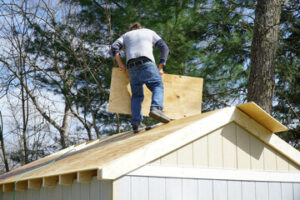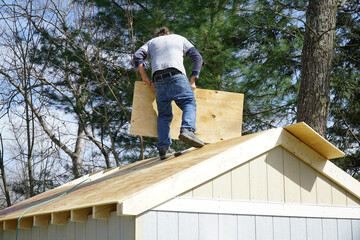If you have a rotting shed that’s taking up space in your yard, it might be time to get rid of it. Before beginning the demolition process, you should empty it of any hazardous materials (like propane and leftover paint) and dispose of them properly.
Then, you can start to dismantle the shed by removing windows and doors and breaking down the floor. This will make the shed easier to maneuver and load into a dumpster. Keep reading the article below to learn more about Old Shed Removal.
The cost of tearing down an old shed can be high depending on the size of the structure and the type of materials used. Those interested in saving money on the removal process should consider salvaging materials that can be reused, such as wood planks and shelving. This will help to lower the overall removal costs and may be possible even if the shed is already on a concrete foundation.
Sheds that are wired for electricity or have plumbing will require professional assistance to ensure the proper disconnection of these services. A qualified electrician near you or plumber can perform this service safely. In addition, if the shed has asbestos in the side paneling or roof, a professional should be hired to remove it.
When tearing down an old shed, homeowners should start by removing any doors or windows and other non-structural parts of the building. This will make the demolition process much faster and easier. The next step is to dismantle the shed frame. This can be done by removing the shed’s floor connections using pliers and an adjustable wrench or by using a reciprocating saw. The wooden walls can then be pried apart or knocked down with a sledgehammer. Once the shed is broken down, it should be placed on a trailer or truck for disposal.
If your shed has a metal roof, it will need to be removed prior to tearing down the rest of the structure. This can be done by removing the screws and nails holding the sheet metal in place. A hammer or chisel can be used to pry up any caulking that is holding the metal in place. Once the shed is separated from the ground, it can be taken away by a junk removal company.
It is important to note that a permit may be required in order to dispose of an old shed. Homeowners should check with local authorities to determine if this is the case. In addition, if the shed is old and sagging, it may be at risk of structural collapse. This is another reason why hiring a professional can save you money and time.
Safety
Before you begin the demolition process, make sure that all necessary equipment is on hand. You will need a variety of tools to dismantle an old shed, including a crowbar, hammer, drill, screwdriver, saw, and safety gear. You should also have tarps available to catch the debris as you work. This will make cleanup a lot easier. You may also want to consider renting a dumpster for the removal of any hazardous materials, such as leftover paint, pesticides, or propane.
To begin the demolition, you should start by removing any non-structural elements from the shed. This includes shelving, storage, and windows. You should also disconnect any power outlets. Once you have done this, it is time to get started tearing down the shed itself. This should be done from the top down. Start by removing the roof, and then continue to dismantle the connections between the floor and the walls. Once these are removed, you should remove the flooring and any concrete slabs that are present.
If the shed is made of wood, you should use a crowbar to remove the panels. This process is typically easier than removing concrete, but it is still important to take your time. It is also a good idea to wear safety glasses, gloves, and boots during this process. You should also remove any rusty nails or screws before they can damage the surrounding property. Finally, you should find a safe spot to keep the panels and place them away from where you are working.
Once the shed is dismantled, you will need to clean up the debris and dispose of it properly. This can be a difficult task, especially if you are dealing with an older shed that has been exposed to the elements for a long period of time. You should also look for any rotting or moldy areas of the shed, as they will need to be disposed of quickly.
If you are unsure of how to properly dispose of your old shed, it is best to hire a professional. They will have the equipment and experience to remove the shed safely. They will also be able to recycle any parts that can be reused.
Preparation
When it comes to tearing down an old shed, there are a few things that need to be done in order to ensure it is safe, efficient and done correctly. The first step is to make sure the shed is empty and free of any hazards that could cause injury or damage during demolition. This can be easily accomplished by sorting through the items in the shed and deciding what is going to be kept, recycled or disposed of. It is also a good idea to check with your local municipality about what materials can be kept in the shed and what may need to be disposed of separately.
Once the shed is empty, the demolition process can begin. The most important thing to remember is to take your time and work safely. This means wearing safety gear, keeping the area clear of people and animals, and using a tarp to contain any debris as it is removed from the shed. In addition, it is a good idea to have some basic tools on hand like a crowbar, hammer, pliers, screwdriver and saw.
The first thing that needs to be done is removing any windows and doors from the shed. These can be removed by unhinging them or removing the screws that hold them in place with a hammer and chisel. Next, the roof will need to be removed. This can be a little tricky, but it is a lot easier when there is someone to help hold the shed while you are working on it. Start with the side that had the door in it as this is likely the least structurally sound and then work your way around.
After the roof is removed, the walls will need to be dismantled. This can be a bit tricky as the dismantling of one wall can cause the remaining walls to become unstable. It is a good idea to have a friend or family member help you with this part of the process and to watch out for any asbestos in the floor or side panels as they are being taken down.
Cleaning up
Sheds can easily become messy and cluttered with tools, gardening supplies, machinery, and trash. When it is time to clean the shed, removing and discarding these items can be overwhelming. It may be easier to empty the shed completely before beginning the cleaning process. A good idea is to make a list of all the contents that will need to be removed. This will help with the planning and organization of the shed cleanup.
Once all the contents have been removed, a thorough sweep should be done. This will remove any cobwebs, egg sacs and stray spiders. A vacuum cleaner can be used to suck up the spider webs and eggs for faster and more thorough cleaning. It is also important to rake the yard to pick up any loose debris left behind after the shed is demolished.
It is a good idea to check with local regulations regarding the disposal of hazardous materials. Items such as propane, leftover paint and pesticides need to be disposed of properly. In many cities, residents are required to obtain a permit before altering or demolishing a shed. A quick online search will provide information on permits for demolition in your area.
The first step is to disconnect the power from the shed. It is also a good idea to wear safety glasses and gloves while working. Next, begin removing the windows. It is helpful to have a ladder while taking out the windows. Lastly, the shed roof will need to be taken down. It is best to remove the roof in sections to ensure proper removal and to prevent any accidents or injuries.
After the shed has been dismantled, it is important to sort through the items and decide which can be reused or recycled. This will help to reduce the amount of waste that is generated. If the shed contains wood flooring, it can be repurposed for another use such as a deck or patio. In some cases, the concrete floor can be broken up and used again in a different location. The remaining items can be hauled away for recycling.



